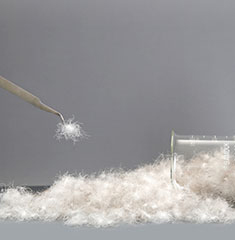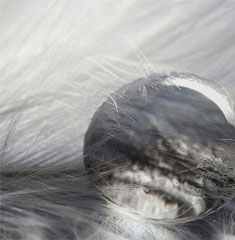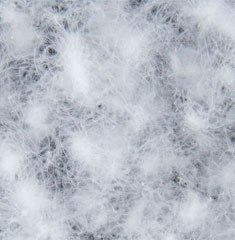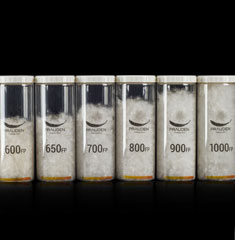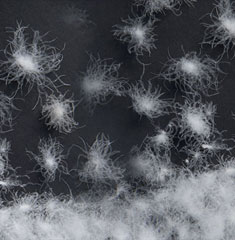
How to Analyze Out ‘Glued Down’ Scientifically?
2018-09-20
Soaring price of down motivates dishonest down manufacturers to mix genuine down with fake down, also known as glued down.
Link to Post: Warning! Counterfeit Glued Down!
It is the industry’s forecast that more fake down products will be found in the market as these gluing attempts are getting ‘tactful and elaborate,’ requiring consumer’s close attention to avoid fake down products. Working with field experts and scientists to track down distribution network of fake down and develop anti-fake technology, the industry is also favored by IDFB (The International Down and Feather Bureau) with its Technology Committee sharing glued down information to the member companies while working closely with the IDFB-qualified inspection labs to develop scientific means to analyze out fake down. FITI Testing & Research Institute, an international testing institution, leads such an attempt in Korea as it has delivered the progress of research at IDFB Meeting Estonia on June 2018.
 <Presentation Delivered at IDFB Meeting Estonia on June 2018 regarding Fake Down Analysis>
<Presentation Delivered at IDFB Meeting Estonia on June 2018 regarding Fake Down Analysis>
This article is courtesy of Dr. Kim Tae-woo, a team leader at FITI Testing & Research Institute who delivered a presentation at IDFB Meeting Estonia regarding fake down analysis.
1. The Glued Down Outline
Glued down uses water-soluble adhesive to mingle chicken feather fiber (CFF) with quality down, increasing the total down weight. Developed to promote recycling chicken feather, CFF is originally intended to be used as thermal insulators or complex materials, not for such a deceptive use. For more information about production of glued down and latent problems, visit here.
2. Macroscopic Analysis
Contrary to a normal down cluster pivoted on a core where fibers stem out, a glued down cluster has multiple cores mingled to each other.
 <Normal Down Cluster (Left) and Glued Down Cluster (Right)>
<Normal Down Cluster (Left) and Glued Down Cluster (Right)>
These artificially glued cores can be separated by a pair of tweezers, into separated cores and a number of fibers. As illustrated below, the separated cores, once mingled to each other, are misshaped contrary to normal down clusters:
 <A Glued Core (Left) and Fibers (Right) Separated>
<A Glued Core (Left) and Fibers (Right) Separated>
Inside of a glued core you can see with naked eyes down and feather, genuine or chicken-oriented, more tightly mingled to each other, barely separable by a pair of tweezers.
A core of mingled fibers and feathers is barely separable by a pair of tweezers. On occasion, you can see chicken feathers are mingled with the core as illustrated below:
 <CFF Mingled with Glued Down Core>
<CFF Mingled with Glued Down Core>
3. Microscopic Analysis
Unless very evident CFF is not macroscopically visible, and this is why microscopic analysis should come into play to view the CFFs separated from a core. A chicken feather stems from nodes of barbules shaped quite different, featuring bamboo-like joints, from the way normal down is.
 <(From left to right) Goose Down Fiber, Duck Down Fiber and Chicken Fiber Magnified>
<(From left to right) Goose Down Fiber, Duck Down Fiber and Chicken Fiber Magnified>
 <Magnified CFF Separated from A Glued Down Core>
<Magnified CFF Separated from A Glued Down Core>
According to head-to-head comparison of down contents out of 100 CFF fibers and 100 normal down fibers, the glued down contained 4 to 5 times as many CFFs as normal down.
| Glued Down #1 | Glued Down #2 | Normal Down | |
|---|---|---|---|
| Chicken Fiber | 32% | 21% | 6% |
| Waterfowl | 68% | 79% | 94% |
<Species of Fiber in Percentage – High CFF Content for Glued Down Specimens>
4. Proteomic Analysis
Not all duck down and goose down, and even chicken feather as well, has microscopically viewable nodes of barblues. In fact, the percentage of barblues that have no viable nodes is very high, where these node-free barbules are not counted in a microscopic analysis. ISO’s proteomic analysis (ISO/DIS 20418-2) effectively supplements such a shortcoming as it analyzes the peptide mass of animal proteins in its attempt to tell animal species.
Difference in the peptide mass of animal proteins stems from amino acid sequences that are specific to animal species as goose down and duck down have 1171 m/z of peptide mass while chicken feather has 1202 m/z. If a core having peptide masses of both 1171 m/z and 1202 m/z, it can be said that core contains chicken feather. Going further, if the magnitude of 1202 m/z peptide mass is high, it can also be said the core has significant amount of chicken feather.
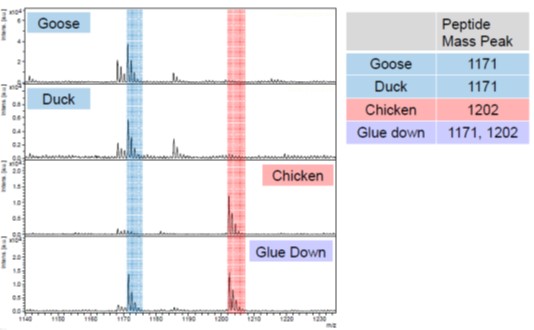 <Peptide Masses Analyzed for Goose down, Duck down and Chicken Feather>
<Peptide Masses Analyzed for Goose down, Duck down and Chicken Feather>
Analysis is quite scientific that fake down products can be weeded out. What is more important, however, is that those scammy down manufacturers must stop faking for the industry to regain trust from consumers because that will be the one and only way to protect consumer right for good.
* Special thanks to Dr. Kim Tae-woo from FITI Testing & Research Institute for proofreading of this article.
By LEE Mi-ra, Sourcing Part, PRAUDEN






